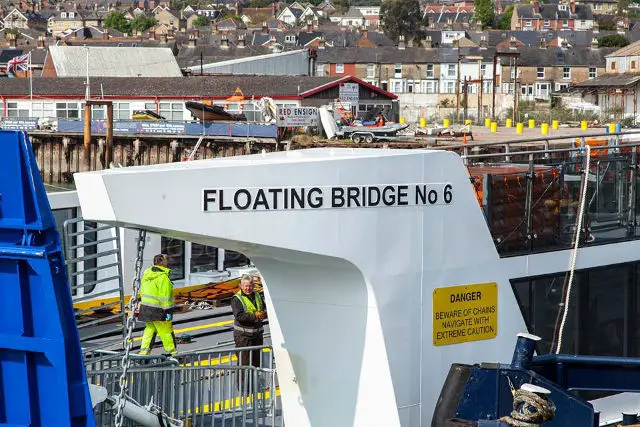Angela Booth, owner of Valu-4-U, shares this latest with OnTheWight about the Cowes floating bridge. Ed
At last night’s East Cowes Town Council Meeting, East Cowes residents and businesses issued a paper to the Town Council through Public Questions, outlining numerous permanent problems beyond the prows and electrical system that cannot be fixed or to resolve them would mean that the bridge will slow down to a crawl.
This isn’t ‘teething trouble’; this is an unmitigated disaster. We were promised an Efficient, Larger (including pedestrians), Reliable, Faster and Customer-friendly (including pedestrians), and those criteria have failed to be met, and instead of a bespoke bridge, we got a wonky banger that is slower, more dangerous and completely unfit for purpose.
We refuse a floating bridge that does not meet these needs and those promises.
Council officers and councillors were warned
Not only we and the East Cowes Town Council were not consulted properly, but also quite a few members of the public went out of their way to warn Council officers and Councillors of these potential problems – many of which were common sense that did not require advanced engineering skills – and now those problems that were ignored by the IW Council, including Health & Safety problems, have come home to roost.
We are angry, and this bridge is unacceptable. As usual, the Council will try to attach plasters and then ‘normalise’ this to preserve their damaged reputation, but we will not allow it.
Many other problems
Beyond the obvious issues experienced so far with the prows and the electrical system, there are many problems that appear that they cannot be resolved due to the design of the bridge or without severely slowing down the bridge, including:
- Dangerous queuing on the East Cowes north pavement (warned to the Council in 2010, 2012, 2014 and onward), including too many people in too little space, “Death Corner” traffic, difficulty crossing to Ferry Road for abled and disabled pedestrians, and no room for lorries to turn down Castle Street coming out of GKN or generally down Ferry Road
- Removal of the slipways’ flood barriers which will cause more regular flooding in Cowes and East Cowes and a rise in flood insurance for local businesses and residents
- One inside pedestrians’ hold – reduced sheltered pedestrian capacity with limited disabled access
- Crossings or river traffic may have to stop more and/or for longer at low tides due to bridge length
- Potentially more changes to infrastructure, particularly the East Cowes slipway and pavements on the north side, causing other delays and costs
- Cold, exposed queuing on the north side of East Cowes pavements
- Slowed crossings with separate (non-simultaneous) offloading of pedestrians and of vehicles, especially as older and disabled people feel rushed to get on to and off of the floating bridge
- The “double decker bus” effect: slow pedestrian exiting due to one exit and two levels of pedestrians trying to exit through one door , and since there is only one pedestrian exit now.
- Any slowing of the bridge will cause attrition of pedestrians and vehicles and become a barrier to island road traffic and pedestrians (and direct impact on traffic in Newport)
Even if they slow down the crossings to a crawl, this will not fix problems such as, for example, the fact that the bridge has only one sheltered pedestrian hold. The only way to mitigate problems with the pedestrian walkways is to offload pedestrians separate from cars, and let them walk towards the south side of the slipway and up, but this will slow down the bridge, and we were promised simultaneous offloading (as one can see in the design of the prow now), which they could have done if they had had two holds and weren’t so obsessed with trying to charge pedestrians.
Negative impacts for charging pedestrians
The Solent Local Enterprise Partnership awarded the Isle of Wight a grant to purchase the floating bridge. However, according to statements made by IW Councillors at the time as well as discussions around the need for a floating bridge consultation, allegedly the IW Council introduced the charges to demonstrate to the Solent LEP that they raise much more money and would ring-fence all floating bridge profits.
It seems that the IW Council may not have explained the potential negative impacts for charging pedestrians at the time, or possibly since, the losses to their pensioner bus passes and other problems with charging.
Fares not being ring-fenced?
Allegedly, according to the last few IW Council budgets, even the vehicle fares have not been ringfenced to secure the future of a future floating bridge, as we were led to believe was being ‘required” by the LEP.
Is the Solent LEP aware of this? We will be writing letters to the LEP – as will the East Cowes Town Council, agreed by motion last night – to find out how satisfied they are with how their money has been spent.
Pensioners using buses costing the council
Additionally and importantly, as the East Cowes public has pointed out for years now, charging pedestrians is losing the Council profit because of the pensioner bus pass use on the bus, where the Council has to pay Southern Vectis a lot of money for pensioners going around by bus, and other expenditures not accounted for in the IW Council budget.
The charges haemorrhage money from the IW Council for multiple reasons from ticket collectors, to pensioner bus passes to attrition. Why do something that is costing your business money? Even if it were to gain a few pounds, the damage that it is doing to the local economy – which is ALSO the responsibility of the IW Council – is massive.
Demands
We are demanding:
- full disclosure of the feasibility study/studies, Health and Safety risk assessments of the bridge, slipways, and affected roads and pavements, all contracts and all legal documents, specifications (and rationale for prioritisation), tender assessment, contract management, acceptance criteria, final takeover conditions and penalty clauses, including how much of the contract payment has been paid out based on performance testing and how much retention payment is held by the Isle of Wight Council
- Immediate IW Council meetings with members of the public, East Cowes Town Council (as passed by motion at last night’s ECTC meeting)
- the immediate cessation of pedestrian charges on the floating bridge
- full disclosure of conversations with the Solent LEP regarding procurement of the floating bridge
- All information about who was responsible – for the design and all of the related ‘sign-offs’
- other requirements as outlined in the document submitted to the East Cowes Town Council
Compensation for loss of turnover
The impact on our businesses is no joke. This has been going on for the better part of six months now, and there is no resolution that will make the bridge as fast as the old one. Some members of the East Cowes Business Association are demanding compensation from the IW Council for massive losses of turnover.
Originally the IW Councillors promised a bridge by March 2016 when talks happened with the Solent LEP.
Incredibly late, substandard atrocity
Then instead of making the floating bridge the same size as it always had been, someone decided to make the bridge too big and that required the bridge being out of service much longer than if it had been a proper replacement.
Now we have a incredibly late, substandard atrocity sitting out there when we would have been better off with a bridge the same size but with internal improvements to the engine etc. It appears that the East Cowes Town Council wishes to get to the bottom of this and who is responsible, and the public also wants to know exactly who made these decisions.
‘Heads should roll’
As the saying goes, ‘heads should roll’ with this inexcusable mistake, and no apathy here – we won’t stop demanding it until this problem is solved.
Attached below: East Cowes’ public’s document to the East Cowes Town Council, 18 May 2017, that includes more demands for information and action of the IW Council and others.





